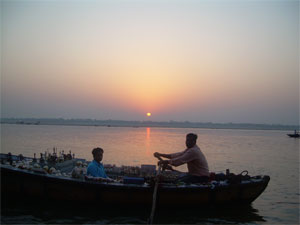TABLE
OF CONTENTS
|
Discovering Varanasi

By Sarah Grimaldi
Although
I visited Agra, Delhi,
and Chennai, my most memorable visit in India
was the city of Varanasi.
Each of these cities gave me a cultural sense of India
but Varanasi
struck me as the most unique with differences I have never witnessed
before. Varanasi is considered a sacred
city and is home to the
holy Ganges
River. As my
travel partners and I made
our way to the river at 5am, the streets were filled with small tea
shops, milk
stands, and also several vendors selling goods. As I observed the
environment
that surrounded me, a parade of men sang a religious song as they
walked past
me heading to the sacred River Ganges. The Indian people perform ritual
baths
in this river and bodies are cremated with ceremonial importance.
Strikingly
there are dead bodies and animals in this same sacred river. My tour
guide
informed me that even if people become sick from this highly polluted
river,
they believe that it is sacred and have become sick from some other
source.
Sickness from the Ganges
River is
unheard of.
There
was no form of modern infrastructure whatsoever in the city of Varanasi. The
stores are shacks with few
items to choose from, and the barber shops consist of mirrors hung
outside with
a chair in front. The smell of mildew reflected the battered- down
buildings
that surround the city. There were cows, wild dogs, and monkeys roaming
the
streets and bathrooms seemed nonexistent as the streets seemed to fill
its
place for the animals and the people. In juxtaposition to these sites
was the
beautifully decorated temples scattered throughout the city. The people
in Varanasi
visit their
temples and shrines once, twice, or even three times daily.
As
I observed the infrastructure in Varanasi,
I reflected on the fact sheet I read about Chennai and Mumbai. What I
witnessed
in Varanasi is only a small portion of India.
Chennai
having a surge of foreign investment and Mumbai with its huge
entertainment
industry and skyscrapers are completely different from this city with
hardly a
two story building in it. The fact sheet read that Navi Mumbai is one
of the
largest planned city projects of the world. Varanasi seemed to be completely
opposite.
The barely paved roads and traffic chaos made it seem even more distant
to structured
Mumbai.
As
we walked through Varanasi,
countless vendors and beggars bombarded us because we were foreigners.
What was
particularly unique about this situation is that the Varanasi vendors
would at first speak to us
in a foreign language such as Spanish or French.
This strongly reinforced the idea of globalization
and how it affects
communication. Not only are multiple languages spoken in important
industrial
and financial centers, but even in a developing city such as Varanasi at the
remote River Ganges.
Witnessing the most distant forms of lifestyles and environment I am
accustomed
to, the city of Varanasi
strongly tested my understanding of another culture unlike ever before.
I feel
I have made an accomplishment by beginning to understand the people of Varanasi through
my
observations and appreciating it as highly enriched learning experience
that I
am grateful for.
|

